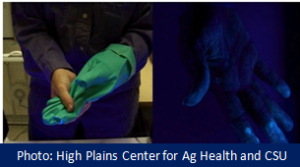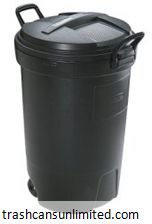Cleaning and maintenance instructions from the PPE manufacturer must be followed for reusable PPE. Never reuse any type of disposable (one-time use) PPE equipment, because you can be exposed to residues remaining on the PPE from the previous use, or to product moving through damaged or deteriorated PPE during reuse.
Note that reusable or limited-use PPE must be discarded if not cleaned and maintained properly because there is a significant risk of pesticide exposure. For example, pesticide exposure can occur from residues remaining from the previous use, damaged seals in the respirator, small holes or tears in gloves or clothing, or degradation of the chemical-resistant PPE.
 Remove PPE as soon as you complete the tasks where you were exposed to the pesticide. Wash disposable OR reusable gloves with soap and water, and then remove other PPE while still wearing the gloves. Then wash the gloves again with soap and water before removing them. Clean reusable PPE according to the PPE instructions, without causing contamination to yourself. Washing gloves prior to removal avoids contamination, shown at right.
Remove PPE as soon as you complete the tasks where you were exposed to the pesticide. Wash disposable OR reusable gloves with soap and water, and then remove other PPE while still wearing the gloves. Then wash the gloves again with soap and water before removing them. Clean reusable PPE according to the PPE instructions, without causing contamination to yourself. Washing gloves prior to removal avoids contamination, shown at right.
Wash regular work clothes that have been exposed to pesticides as soon as possible to ensure maximum pesticide residue removal. Wash them separately from other laundry using detergent and hot water. Using an outdoor clothesline rather than a dryer may help break down any remaining pesticide residues. If no PPE is required on the pesticide label, it is still wise to wash clothes promptly.
Always obtain replacement parts for half and full-face respirators from the original manufacturer and repair PPE in accordance with manufacturer instructions. Respirator component parts are NOT interchangeable between different manufacturers.
 Storage instructions from the PPE manufacturer must be followed for both reusable and disposable PPE. Most PPE must be protected from chemicals, sunlight, extreme temperatures, excessive humidity, and moisture, or the specified shelf-life will be reduced. Disposable, reusable, or limited-use PPE must be discarded if not stored properly.
Storage instructions from the PPE manufacturer must be followed for both reusable and disposable PPE. Most PPE must be protected from chemicals, sunlight, extreme temperatures, excessive humidity, and moisture, or the specified shelf-life will be reduced. Disposable, reusable, or limited-use PPE must be discarded if not stored properly.
Keep PPE in its sealed package until use, and never store PPE with pesticides or personal clothing.
 Disposal is the critical last step in handling PPE. Ensure that you remove and discard PPE without causing contamination to yourself, garbage collectors, or the environment. PPE may have an expiration date, while other PPE requires careful inspection – read the PPE manufacturer directions and be diligent about the disposal of PPE that will no longer provide protection.
Disposal is the critical last step in handling PPE. Ensure that you remove and discard PPE without causing contamination to yourself, garbage collectors, or the environment. PPE may have an expiration date, while other PPE requires careful inspection – read the PPE manufacturer directions and be diligent about the disposal of PPE that will no longer provide protection.
Clean disposable, washable items with soap and water prior to disposal, to remove pesticide residues. Properly cleaned PPE can be disposed of as regular garbage.
PPE that is contaminated with a pesticide must be disposed of according to directions on the pesticide product label and all federal, state, and local regulations. In the absence of specific label directions or government regulations, dispose of contaminated PPE as household hazardous waste, which can be taken to an appropriate waste collection event or disposal site.
If all PPE instructions for cleaning, maintenance, storage, and disposal are not followed carefully, PPE can become ineffective or even increase exposure to a pesticide. If in doubt, dispose of the PPE or PPE component.
Compiled by Wayne Buhler, PhD. and David Jefferson
